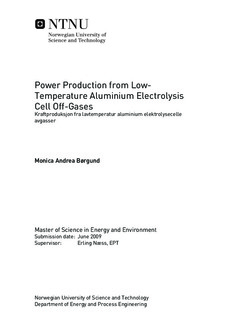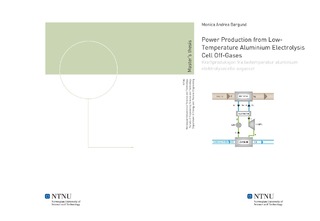| dc.description.abstract | The objective of this report is to determine the feasibility of installing a waste heat power production unit in connection to the fume treatment plants at AAM and to determine its performance characteristics.The specific cycles for electricity production suited for low temperature heat sources were discussed, these include the Stirling cycle, the organic Rankine cycle (ORC) and the Kalina cycle. The ORC proved to be the best suited technology for power production from low temperature waste heat. This is due to its superior thermodynamic properties to the steam Rankine cycle. Furthermore, the cycle is better developed and documented than the Stirling and the Kalina cycle. However, the industry for producing power from industrial waste heat is under rapid development, and the same conclusion might not be valid in a couple of years.The ORC unit was adapted for flue gas heat recovery in connection to the ÅI fume treatment plant (FTP) by identifying the properties of the heat source and heat sink. Furthermore, working fluids contained in the REFPROP 8.0 database were simulated and an optimization to find the optimal working fluid for a direct and an indirect system design was done. R227ea proved to be the best performer both in the direct and the indirect system design with an average power output of 2262 kW and 2153 kW, respectively. This resulted in a 5 % lower power output for the indirect design. The outline of the power production unit was found by looking at the local conditions and the layout of the future ÅI FTP. The result was an indirect system with four raw gas heat exchangers connected in parallel to a water circuit supplying hot water to the ORC unit. Even tough R227ea proved to be the best performer in the working fluid simulations, R134a was chosen as the working fluid for the final system design based on ORC manufacturer?s practical experience with the working fluids. The net power output from the power production unit was identified by adding additional system restrictions to the ORC simulation model, and including power consumption from all auxiliary system components. The final system design had an average net power output of 1726 kW, 21% lower than in the preliminary indirect design. Four system solutions received from ORC manufacturers Opcon and Turboden were compared based on system performance and financial viability. The performance estimates all had inferior power outputs to the simulated ORC. This was partially due to different system constraints, but mostly due to the different simulation targets. While the commercial units are optimized for minimum cost per kW, the simulations done in this thesis are optimized for maximum power output. Only one of the commercial performance estimates fulfilled the minimum rate of return requirement set by Hydro (11 %). The installation of two Opcon Powerbox modules with ammonia as working fluid is profitable with a financial support of 16.25 % ( 4 062 708 NOK). Moreover, if the ORC unit is to be installed in connection to the construction of a new FTP, the investment costs of the ORC are expected to be smaller as a gas cooling system is likely to be installed nevertheless. | nb_NO |

